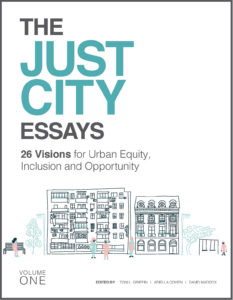“Five years ago, the Harvard Graduate School of Design’s Just City Lab published The Just City Essays: 26 Visions of Inclusion, Equity and Opportunity. The questions it posed were deceptively simple: What would a just city look like? And what could be the strategies to get there? These questions were posed to mayors, architects, artists, philanthropists, educators and journalists in 22 cities, who told stories of global injustice and their dreams for reparative and restorative justice in the city.
 These essays were meant as a provocation, a call to action. Now, during these times of dissonance, unrest, and uncertainty, their contents have become ever more important. For the next 26 weeks [starting June 15, 2020], the GSD and the Just City Lab will republish one essay a week here and at designforthejustcity.org. We hope they may continue conversations of our shared responsibility for the just city.
These essays were meant as a provocation, a call to action. Now, during these times of dissonance, unrest, and uncertainty, their contents have become ever more important. For the next 26 weeks [starting June 15, 2020], the GSD and the Just City Lab will republish one essay a week here and at designforthejustcity.org. We hope they may continue conversations of our shared responsibility for the just city.
We believe design can repair injustice. We believe design must restore justice, especially that produced by its own hand. We believe in justice for Black Americans. We believe in justice for all marginalized people. We believe in a Just City.”
—Toni L. Griffin, Professor in Practice of Urban Planning, founder of the Just City Lab, and editor of The Just City Essays
Ceci n’est pas une pipe: Unpacking Injustice in Paris
By François Mancebo
“We all know the sound of two hands clapping. But what is the sound of one hand clapping?” says a famous Zen Koan. At first consideration, it seems impossible to conjecture about the “just city” without having already in mind what is an “unjust city,” and vice versa. But my opinion is that this is wrong: It is possible to define what a “just city” is per se. To give flesh and substance to this essay I will focus on Paris and sustainability. First, because they are my fields of expertise, but also because sustainability and justice are two alleged priorities cited lavishly by planners and elected officials to promote their urban policies. Their doxa considers that these two priorities are perfectly synergistic, but they are not. Planning for one may produce redlines in the other: sustainable policies often increase social injustice, as shown by Elizabeth Burton in a large sample of U.K. cities,¹ or by Neil Smith when he denounced the veil thrown over profoundly unfair environmental dynamics that involve the departure of socially vulnerable people out of newly gentrified ecological neighborhoods.² In fact sustainability and justice are like two rival brothers, and combining them in urban policies is certainly challenging.
One among the many challenges of urban sustainability is re-establishing the inclusiveness of the urban fabric instead of just popping up buildings and projects. But generally, it doesn’t work like that. Mayors, representatives and other elected officials adore showcasing constructions, and they love them brand new. They are so much more visible. They are less interested in urban design and holistic approaches, which are more important for fostering sustainability but harder to implement and less profitable as an electoral issue.
Thus, a sustainable city should result from the confrontation—or the synergy—of choices made by multiple actors, each acting for its own concern. But usually, only elected officials, developers and technical staff are invited to the table, which is a big mistake. All those who are affected by the decisions should be involved in the process of decision-making, as shown by the failure of La Trame verte et bleue (green and blue Grid) in the region of Paris (a land management tool for the preservation of biodiversity). Local and regional authorities forgot a few things when fixing them. They forgot that livability, justice and sustainability are technically three different things, but three things that should contribute together to what the people affected by their policies will call a “good environment.” A “good environment” is one in which the improvement of environmental conditions sensu stricto (water quality, air, biodiversity, etc.) leads to improved living conditions. A polluted environment can be a place where life is good. Conversely, an environment with clean air and clean water can be quite intolerable, as evidenced by windswept, segregated social-housing complexes settled in the middle of nowhere, where the quality of life is low. The developers of La Trame verte et bleue just didn’t care to ask the people what a “good environment” was for them, much less make room for them at the decision-making table, as I explained in a recent paper.³ Do you know that the current regional master plan of Paris proposes—as an important means to foster sustainability—a quantitative objective of 10m² of public green area per inhabitant? As though it were sufficient to display “green” to become suddenly sustainable. Amazing, isn’t it?
Urban sustainability should be about designing a new social contract that addresses the following questions: What type of society do we want to live in? Which compromises are necessary between the goals and interests of the different actors? Continue reading on designforthejustcity.org…
¹ Burton E., 2000, “The Compact City: Just or Just Compact? A Preliminary Analysis,”Urban Studies, vol. 37, n° 11, pp. 1969-2006
² Smith N., 2002, “New Globalism, New Urbanism: Gentrification as Global Urban Strategy,” Antipode, n° 34, pp. 427-450.
³ Mancebo F., 2015, “Combining Sustainability and Social Justice in the Paris Metropolitan Region,” Sustainability in the Global City: Myth and Practice, Isenhour C., McDonough G., Checker M. eds, Series New Directions in Sustainability, pp. 263-283, Cambridge University Press.
